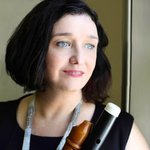Chestnut Hill’s Woodmere Art Museum will host New World Recorders in recital Sat., Feb. 25, at 5 p.m. The repertoire will include music by Dufay to Bach and even on to Schumann and beyond.
This item is available in full to subscribers.
We have recently launched a new and improved website. To continue reading, you will need to either log into your subscriber account, or purchase a new subscription.
If you are a digital subscriber with an active subscription, then you already have an account here. Just reset your password if you've not yet logged in to your account on this new site.
If you are a current print subscriber, you can set up a free website account by clicking here.
Otherwise, click here to view your options for subscribing.
Please log in to continue |


Chestnut Hill’s Woodmere Art Museum will host New World Recorders in recital Sat., Feb. 25, at 5 p.m. The repertoire will include music by Dufay to Bach and even on to Schumann and beyond.
When I asked Gwyn Roberts, the Quartet’s founder and director, to explain the inspiration of the ensemble and the program, she answered, “New World Recorders had its genesis in the summer of 2017, when four recorder players, who perform with Tempetsa di Mare, agreed to play Bach’s ‘Art of the Fugue’ together on Tempesta’s Artist Recital Series. Those concerts in April, 2018, were followed by an additional performance and a full-day workshop on fugues, presented by Capitol Early Music in Washington, D.C.
“We enjoyed the project so much that we decided to name the group,” Roberts continued. “Our second project together was Purcell’s Fantazias, also on Tempesta’s Artist Series, and our third was English music in collaboration with the New York City viol consort, Parthenia. Our fourth project, ‘The Four Winds,’ featured Baroque music for multiple woodwinds and continuo and was performed in a tent during the pandemic lockdown”
Roberts said that the quartet for this concert will be Rainer Beckmann, Heloise Degrugillier, Sarah Shodja and herself. “Rainer was born in Germany, Heloise in France, Sarah in Iran and I was born in the U.S. Rainer, Heloise and I studied at Utrecht Conservatory in the Netherlands, and Sarah studied with me at the Peabody Conservatory of Music in Baltimore.”
The program focuses on musical forms. The music chosen comes from the 15th through the 20th centuries that projects a clearly audible beginning-middle-end arc, whether within a single movement or across the multi-movement score.
Roberts added, “Rainer and I did most of the program construction together, with ideas from Heloise and Sarah. While there are some transcriptions here (hard to avoid in an all-recorder program spanning centuries), most of the music is either specifically for recorders or is for a consort of unspecified instruments. I made many of the editions myself, with some adapted from Richard Stone’s work and some passed along by colleagues.”
For ticket information call 215-755-8776 or visit tempestadimare.org.
French Baroque in Germantown
Under the direction of John Walthausen, music director at the First Presbyterian Church in Germantown, Variant 6 and Filament performed an all-French program of Baroque music Sunday, Feb. 12. For those of us who were soon to be disappointed by the Eagles’ loss at the Super Bowl, the concert was a balm looking back and recalling its singular beauty.
The program was comprised of three sections: the first and last featuring music by Marc-Antoine Charpentier (1643-1704); the middle proffering a collection of music written by a bevy of Charpentier’s contemporaries. That survey boasted musical settings sung by Ursuline nuns in 18th century New Orleans that were based on older manuscripts sent to them from France.
Bookending this “potpourri” were Charpentier’s “Caecillia, virgo et martyr” and “Litanies de la Vierge.”
Conducting from the harpsichord, Walthausen led Variant 6 (sopranos Jessica Beebe and Rebecca Myers, mezzo Elisa Sutherland, tenors Steven Bradshaw and Daniel Taylor and bass Daniel Schwartz) and Filament (violinists Evan Few and Mandy Wolman, viola da gambist Elena Kauffman and theorbist Kevin Payne) in sterling performances of both works by Charpentier.
“Caecillia” is a sacred cantata that narrates the martyrdom of the ancient Roman Saint Cecelia, who has come down to Roman Catholics and Greek Orthodox as the patron of music. Each of the singers in Variant 6 took on the roles of the libretti. Beebe’s platinum soprano paired beautifully with Myers’ golden timbre while Sutherland’s bronze shades supported them both. Similarly, Bradshaw’s shining tenor blended well with Taylor’s glowing colors, while Schwartz’s burnished tones underpinned their efforts. Under Walthausen’s direction, Filament provided sensitive support.
The rendition given the “Litanies” was the concert’s high point. Like a pearl surrounded by diamonds, Myers and Beebe’s voices projected the treasured medieval text of Marian devotion that warmed the heart of a traditionalist Catholic like myself. And, like a supporting cast of the gemstones sapphire, ruby, emerald and amethyst, Sutherland, Bradshaw, Taylor and Schwartz offered a lyrical foundation for their soaring singing. Once again, Walthausen conducted his singers and Filament in a compelling reading of an overlooked yet compelling masterpiece.
Choral Arts Philadelphia
Matthew Glandorf will conduct Choral Arts Philadelphia in concert Saturday, March 4, at 4 p.m. in the Episcopal Church of the Holy Trinity, Rittenhouse Square, Philadelphia. The program will feature Johann Sebastian Bach’s “Wer weis, wei nahe mir mein Ende” (“Who knows how near my end is to me?”) and the commissioned premiere of Chelsea Komschlies’ “If Thou but Suffer God to Guide Thee.”
The new cantata features a libretto by local writer Anthony Corvaia, who commissioned the score to be composed. To learn more about the new work, read NOTEWORTHY next week. For ticket information, visit www.choralarts.org.